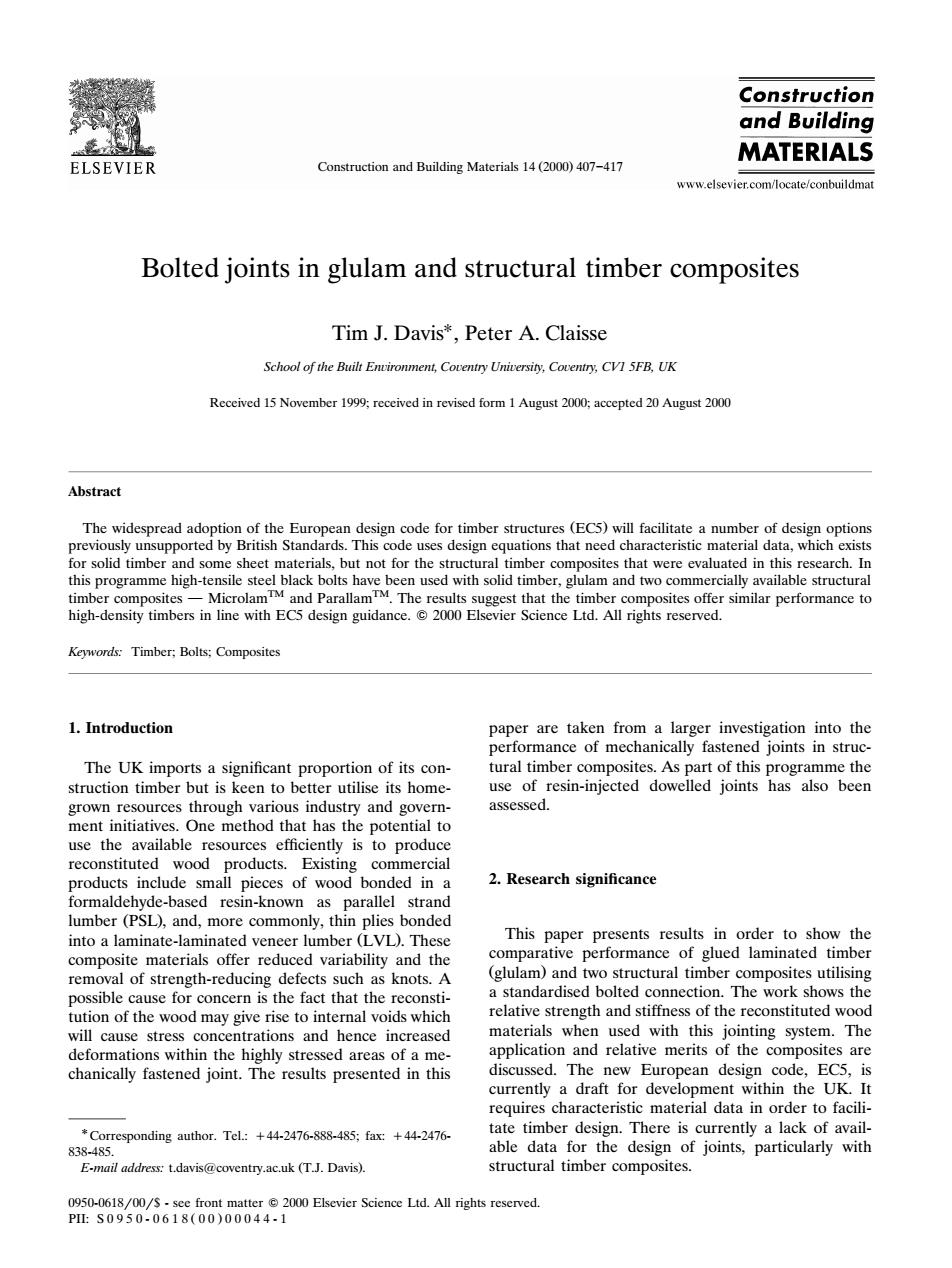正在加载图片...

Construction and Building ELSEVIER Construction and Building Materias 1(0)407-417 MATERIALS www.elsevier.com/locate/conbuildmat Bolted joints in glulam and structural timber composites Tim J.Davis*,Peter A.Claisse School of the Built Environment.Coventry University.Coventry.CVI 5FB.UK Received 15 November 1;received in revised Abstract evouta Standard Th oden that nd characersatedat this programme high-ten r similar performance to Keyords Timber:Bolts:Composites 1.Introduction The UK im orts a significant tion of its co sites A of thi use of resin-injected dowelled joints has also been grown resources through various industry and govern- assessed. ment initiati mthod that has the potea products include small pieces of wood bonded in a 2.Research significance umbaldehyde-based resin-known as parallel snded more commo y,t removal of strength-reducing defects such as knots.A standardised bolted conne ction.The work shows the relative strength and stiffness of the reconstituted wood materials when used with this jointing system.The deformations within the highly stressed areas of a me e con chanically fastened joint.The results presented in this currently a draft for developm ment within the UK.It requires characteristic material data in order to facili- 838-485 responding author.Tel +4-247688-485:x+442476 the design tdavis ntry.ac.uk(T.J.Davis). 0Eevier Scne Ld.ll r reedConstruction and Building Materials 14 2000 407 Ž . ]417 Bolted joints in glulam and structural timber composites Tim J. DavisU, Peter A. Claisse School of the Built En¨ironment, Co¨entry Uni¨ersity, Co¨entry, CV1 5FB, UK Received 15 November 1999; received in revised form 1 August 2000; accepted 20 August 2000 Abstract The widespread adoption of the European design code for timber structures EC5 will facilitate a number of design options Ž . previously unsupported by British Standards. This code uses design equations that need characteristic material data, which exists for solid timber and some sheet materials, but not for the structural timber composites that were evaluated in this research. In this programme high-tensile steel black bolts have been used with solid timber, glulam and two commercially available structural timber composites } MicrolamTM and ParallamTM. The results suggest that the timber composites offer similar performance to high-density timbers in line with EC5 design guidance. Q 2000 Elsevier Science Ltd. All rights reserved. Keywords: Timber; Bolts; Composites 1. Introduction The UK imports a significant proportion of its construction timber but is keen to better utilise its homegrown resources through various industry and government initiatives. One method that has the potential to use the available resources efficiently is to produce reconstituted wood products. Existing commercial products include small pieces of wood bonded in a formaldehyde-based resin-known as parallel strand lumber PSL , and, more commonly, thin plies bonded Ž . into a laminate-laminated veneer lumber LVL . These Ž . composite materials offer reduced variability and the removal of strength-reducing defects such as knots. A possible cause for concern is the fact that the reconstitution of the wood may give rise to internal voids which will cause stress concentrations and hence increased deformations within the highly stressed areas of a mechanically fastened joint. The results presented in this U Corresponding author. Tel.: q44-2476-888-485; fax: q44-2476- 838-485. E-mail address: t.davis@coventry.ac.uk T.J. Davis . Ž . paper are taken from a larger investigation into the performance of mechanically fastened joints in structural timber composites. As part of this programme the use of resin-injected dowelled joints has also been assessed. 2. Research significance This paper presents results in order to show the comparative performance of glued laminated timber Ž . glulam and two structural timber composites utilising a standardised bolted connection. The work shows the relative strength and stiffness of the reconstituted wood materials when used with this jointing system. The application and relative merits of the composites are discussed. The new European design code, EC5, is currently a draft for development within the UK. It requires characteristic material data in order to facilitate timber design. There is currently a lack of available data for the design of joints, particularly with structural timber composites. 0950-0618r00r$ - see front matter Q 2000 Elsevier Science Ltd. All rights reserved. PII: S 0 9 5 0 - 0 6 1 8 0 0 Ž . 00044-1